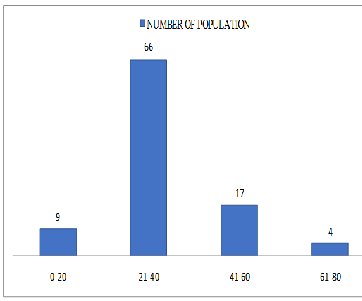A Study on Self-Medication Practice in General Population Visiting to Tertiary Care Teaching Hospitals, Jaipur
Abstract
Background:
Self-medication is defined as the selection and use of medicines by individuals to treat self-recognized or self-diagnosed conditions or symptoms. The meaning of “Self-medication” word is purchasing or taking drugs without prescription. People choosing self-medication because lack of time, lack of health services, high cost of medical consultation, easy availability of drugs.
Method
This study is a single centred study where 96 subjects were observed and studied to assess self-medication practice at the Jaipur National University for Medical Sciences and Research, Jaipur. Statistical calculation was made by Chi-square test and using SPSS statistics V22.0 software.
Result
Self-medication can cause health severity. Self-medication has a positive impact on 33.33% of the population while having a negative impact on 66.67% of the population. Hence most commonly self medication drugs are analgesic (88.54%) and anti-pyretic (87.5%) According to research, that found risk of self-medication practice like incorrect self-diagnosis, incorrect choice of therapy, rare but severe adverse effects, incorrect route of administration, risk of dependence and abuse.
Conclusion
This research focused on the practice of self-medication, its use, its safety, and the reasons for its use. Self-medication has a positive impact on 33.33% of the population while having a negative impact on 66.67% of the population. It is safe if the people who use it have sufficient knowledge of its dose when to take it, and the side effects in case of overdose, but due to lack of information antibiotic resistance, and skin problems It may lead to serious effects such as hypersensitivity and allergies.
Full text article
References
Bown D, Kisuule G, Ogasawara H, Siregar C, Williams G. WHO guidelines for the regulatory assessment of medicinal products for use in self-medication. WHO Drug Inf. 2000;14(1):18-26.
World Health Organization. The Role of the pharmacist in self-care and self-medication: report of the 4th WHO Consultative Group on the Role of the Pharmacist, The Hague, The Netherlands, 26-28 August 1998. InThe Role of the pharmacist in self-care and self-medication: report of the 4th WHO Consultative Group on the Role of the Pharmacist, The Hague, The Netherlands, 26-28 August 1998.
Schmiedl S, Rottenkolber M, Hasford J, Rottenkolber D, Farker K, Drewelow B, Hippius M, Saljé K, Thürmann P. Self-medication with over-the-counter and prescribed drugs causing adverse-drug-reaction-related hospital admissions: results of a prospective, long-term multi-centre study. Drug safety. 2014;37:225-35.
Ehigiator O, Azodo CC, Ehizele AO, Ezeja EB, Ehigiator L, Madukwe IU. Self-medication practices among dental, midwifery and nursing students. European Journal of General Dentistry. 2013;2(01):54-7.
Abay SM, Amelo W. Assessment of Self-medication practices among medical, pharmacy, health science students in Gondar University, Ethiopia. Journal of Young Pharmacists. 2010 ;2(3):306-10.
Klemenc-Ketiš Z, Hladnik Ž, Kersnik J. A cross sectional study of sex differences in self-medication practices among university students in Slovenia. Collegium antropologicum. 2011;35(2):329-34.
Sawalha AF. A descriptive study of self-medication practices among Palestinian medical and nonmedical university students. Research in Social and Administrative Pharmacy. 2008;4(2):164-72.
Klemenc-Ketis Z, Hladnik Z, Kersnik J. Self-medication among healthcare and non-healthcare students at University of Ljubljana, Slovenia. Medical Principles and practice. 2010 ;19(5):395-401.
Burak LJ, Damico A. College students' use of widely advertised medications. Journal of American College Health. 2000 ;49(3):118-21.
James H, Handu SS, Khaja KA, Sequeira RP. Influence of medical training on self-medication by students. International journal of clinical pharmacology and therapeutics. 2008;46(1):23-9.
Ghosh S, GUPTA A, CHAUDHARY R. Evaluation of the practice of self-medication among college students in west Uttar Pradesh. International Journal of Pharma Professional’s Research (IJPPR). 2010;1(1):14-8.
Hussain A, Khanum A. Self-medication among university students of Islamabad, Pakistan-a preliminary study. Southern Med Review. 2008;1(1):14-6.
Bennadi D. Self-medication: A current challenge. Journal of basic and clinical pharmacy. 2013;5(1):19.
Montastruc JL, Bondon-Guitton E, Abadie D, Lacroix I, Berreni A, Pugnet G, Durrieu G, Sailler L, Giroud JP, Damase-Michel C, Montastruc F. Pharmacovigilance, risks and adverse effects of self-medication. Therapies. 2016 ;71(2):257-62.
Bennadi D. Self-medication: A current challenge. Journal of basic and clinical pharmacy. 2013;5(1):19.
Jafari F, Khatony A, Rahmani E. Prevalence of self-medication among the elderly in Kermanshah-Iran. Global journal of health science. 2015;7(2):360.
World Health Organization. Guidelines for the regulatory assessment of medicinal products for use in self-medication. World Health Organization; 2000.
Authors

This work is licensed under a Creative Commons Attribution 4.0 International License.
